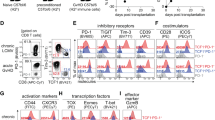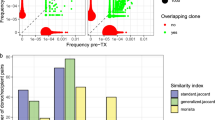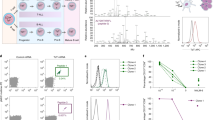Abstract
The facilitating cell is a rare CD8+ bone marrow subpopulation that can enhance allogeneic hematopoietic stem cell engraftment across complete major histocompatibility complex barriers without inducing acute graft-versus-host disease. Here we describe a CD3ɛ-associated complex on the facilitating cell surface that consists of the T-cell receptor β-chain disulfide-linked to a previously unknown 33-kilodalton glycoprotein. Provisionally called FCp33, this glycoprotein does not represent any of the known protein chains or surrogates associated with CD3–T-cell receptor β. Expression of this CD3–T-cell receptor β–FCp33 complex directly correlates with the facilitating cell's functional ability to enhance allogeneic stem cell engraftment in vivo.
This is a preview of subscription content, access via your institution
Access options
Subscribe to this journal
Receive 12 print issues and online access
$209.00 per year
only $17.42 per issue
Buy this article
- Purchase on Springer Link
- Instant access to full article PDF
Prices may be subject to local taxes which are calculated during checkout





Similar content being viewed by others
References
Kaufman, C.L. et al. Phenotypic characterization of a novel bone marrow-derived cell that facilitates engraftment of allogeneic bone marrow stem cells. Blood 84, 2436–2446 ( 1994).
Spangrude, G.J., Heimfeld, S. & Weissman I.L. Purification and characterization of mouse hematopoietic stem cells. Science 241, 58– 62 (1988).
El-Badri, N.S., Wang, B.Y., Cherry & Good, R.A. Osteoblasts promote engraftment of allogeneic hematopoietic stem cells. Exp. Hematol. 26, 110–116 (1998).
Gaines, B.A., Colson, Y.L., Kaufman, C.K. & Ildstad, S.T. Facilitating cells enable engraftment of purified liver fetal stem cells in allogeneic recipients. Exp. Hematol. 24, 902–913 (1996).
Neipp, M., Zorina, T., Domenick, M.A., Exner, B.G. & Ildstad, S.T. Effect of FLT3 ligand and granulocyte colony stimulating factor on expansion and mobilization of facilitating cells and hematopoietic stem cells in mice: kinetics and repopulating potential . Blood 92, 3177–3188 (1998).
Gale, R.P. & Reisner, Y. Graft rejection and graft-versus-host disease: mirror images. Lancet 1, 1468– 1470 (1986).
Armitage, J.O. Medical progress: bone marrow transplantation. N. Engl. J. Med. 330, 827–838 ( 1994).
Tanaka, J., Imamura, M., Kasai, M., Asaka, M. & Torok-Storb, B. The role of accessory cells in allogeneic peripheral blood stem cell transplantation. Int. J. Hematol. 69 , 70–74 (1999).
Murphy, W.J., Bennett, M., Kumar, V. & Longo, D. Donor type activated natural killer cells promote marrow engraftment and B cell development during allogeneic bone marrow transplantation. J. Immunol. 148, 2953–2960 (1992).
Lapidot, T., Faktorowich, T., Lubin, I. & Reisner, Y. Enhancement of T cell-depleted bone marrow allografts in the absence of graft-versus-host-disease is mediated by CD8+CD4− and not by CD8−CD4+ thymocytes. Blood 80, 2406–2411 (1992).
Murphy, W.J., Kumar, V., Cope, J. & Bennett, M. An absence of T cells in murine bone marrow allografts leads to an increased susceptibility to rejection by natural killer cells and T cells. J. Immunol. 144, 3305–3311 (1990).
Sykes, M. et al. Effects of T cell depletion in radiation bone marrow chimeras. III. Characterization of allogeneic bone marrow cell populations that increase allogeneic chimerism independently of graft versus host disease in mixed marrow recipients. J. Immunol. 143, 3503– 3511 (1989).
Martin, P.J. Donor CD8 cells prevent allogeneic marrow graft rejection in mice: potential implications for marrow transplantation in humans. J. Exp. Med. 178, 703–712 ( 1993).
Fowler, D.H., Whitfield, B., Livingston, M., Chrobak, P. & Gress, R.E. Non-host-reactive donor CD8+ T cells of Tc2 phenotype potently inhibit marrow graft rejection . Blood 11, 4045–4050 (1998).
Gallardo, D. et al. Low-dose donor CD8+ cells in the CD4-depleted graft prevent allogeneic marrow graft rejection and severe graft-versus-host disease for chronic myeloid leukemia patients in first chronic phase. Bone Marrow Transplant. 20, 945–952 (1997).
Ley, S.C., Tan, K.N., Kubo, R., Sy, M. & Terhorst, C. Surface expression of CD3 in the absence of the T cell receptor (TCR): evidence for sorting of partial TCR/CD3 complexes in a post-endoplasmic reticulum compartment. Eur. J. Immunol. 19, 2309–2317 (1989).
Wiest, D.L., Burgess, W.H., McKean, D., Kearse, K.P. & Singer, A. The molecular chaperone calnexin is expressed on the surface of immature thymocytes in association with clonotype-independent CD3 complexes. EMBO J. 14, 3425– 3433 (1995).
Groettrup, M. & von Boehmer, H. T cell receptor β chain dimers on immature thymocytes from normal mice. Eur. J. Immunol. 23, 1393–1396 ( 1993).
Groettrup, M. et al. A novel disulfide-linked heterodimer on pre-T cells consists of the T cell receptor β chain and a 33 kD glycoprotein. Cell 75, 283–294 ( 1993).
Samelson, L.E., Harford, J.B. & Klausner R.D. Identification of the components of the murine T cell antigen receptor complex. Cell 43, 223– 231 (1985).
Marrack, P. & Kappler, J. The T cell receptor. Science 238, 1073–1079 ( 1987).
Hochstenbach, F. & Brenner, M.B. T cell receptor delta chain can substitute for alpha to form a beta-delta heterodimer. Nature 340, 562–565 ( 1989).
Kishi, H. et al. Surface expression of the β T cell receptor (TCR) chain in the absence of other TCR or CD3 proteins on immature T cells. EMBO J. 10, 93–100 ( 1991).
Jacobs, H. et al. CD3 components at the cell surface of pro-T cells can mediate pre-T cell development in vivo. Eur. J. Immunol. 24, 934–939 (1994).
Minami, Y., Weissman, A.M., Samelson, L.E. & Klausner, R.D. Building a multichain receptor: synthesis, degradation, and assembly of the T-cell antigen. Proc. Natl. Acad. Sci. USA 84, 2688–2692 (1987).
Mombaerts, P. et al. RAG-1 deficient mice have no mature B and T lymphocytes. Cell 68, 869–877 ( 1992).
Shinkai, Y. et al. Restoration of T cell development in T cell deficient mice by functional TCR transgenes. Science 259, 822–825 (1993).
von Boehmer, H. & Fehling, H.J. Structure and function of the pre-T cell receptor. Annu. Rev. Immunol. 15, 433–452 (1997).
Berger, M.A. et al. Subunit composition of pre-T cell receptor complexes expressed by primary thymocytes: CD3δ is physically associated but not functionally required. J. Exp. Med. 186, 1461– 1467 (1997).
Modigliani, Y., Burlen-Defranoux, O., Bandeira, A. & Coutinho, A. Neonatal tolerance to alloantigens is induced by enriched antigen-presenting cells. Scand. J. Immunol. 46, 117– 121 (1997).
Drobyski, W.R., Majewski, D. & Hanson G. Graft-facilitating doses of ex vivo activated gammadelta T cells do not cause lethal murine graft-vs.-host disease. Biol. Blood Marrow Transplant. 5, 222– 230 (1999).
Ildstad, S.T. & Sachs, D.H. Reconstitution with syngeneic plus allogeneic or xenogeneic bone marrow leads to specific acceptance of allografts or xenografts. Nature 307, 168– 170 (1984).
Meier, T., Arni, S., Malarkannan, S., Poincelet, M. & Hoessli, D. Immunodetection of biotinylated lymphocyte-surface proteins by enhanced chemiluminescence: a nonradioactive method for cell-surface protein analysis. Anal. Biochem. 204, 220–226 (1992).
Altin, J.G. & Pagler, E.B. A one-step procedure for biotinylation and chemical cross-linking of lymphocyte surface and intracellular membrane-associated molecules. Anal. Biochem. 224, 382– 389 (1995).
Laemmli, U.K. Cleavage of structural proteins during the assembly of the head of bacteriophage T4. Nature 227, 680–685 (1970).
Barber, D.F., Passoni, L., Wen, L., Geng, L. & Hayday, A.C. The expression in vivo of a second isoform of pTα: implications for the mechanism of pTα action. J. Immunol. 161, 11–16 ( 1998).
O'Farrell, P.Z., Goodman, H.M. & O'Farrell, P.H. High resolution two-dimensional electrophoresis of basic as well as acidic proteins. Cell 12, 1133–1142 (1977).
Becker, M.L. et al. Expression of a hybrid immunoglobulin-T cell receptor protein in transgenic mice. Cell 58, 911– 921 (1989).
Kubo, R.T., Born, W., Kappler, J.W., Marrack, P. & Pigeon, M. Characterization of a monoclonal antibody which detects all membrane alpha beta T cell receptors. J. Immunol. 142, 2336–2742 (1989).
Ioannides, C.G. et al. Identification of a second T cell antigen receptor in human and mouse by anti-peptide gamma chain-specific monoclonal antibody. Proc. Natl. Acad. Sci. USA 84, 4244– 4248 (1987).
Chen, B.G. et al. Inhibition by CsA and FK506 of the in vitro proliferative response of gamma delta T cells on stimulation with anti-TCR delta monoclonal antibody. Transpl. Immunol. 4, 158– 162 (1996).
Kosugi, A. et al. Subunit composition of the pre-T cell receptor complex analyzed by monoclonal antibody against the pre-T cell receptor α chain. J. Immunol. 91, 618–622 (1997).
Groettrup, M., Baron, A., Griffiths, G., Palacios, R. & von Boehmer, H. T cell receptor (TCR) β chain homodimers on the surface of immature, but not mature α, γ and δ chain deficient T cell lines. EMBO J. 11, 2735– 2746 (1992).
Acknowledgements
We thank R. Lakomy and the Pittsburgh Cancer Institute Flow Cytometry Facility for cell sorting support, as well as M. Mazzocchetti and the Animal Care Facility for animal care. We thank C.L. Kaufman and S.T. Ildstad for their support and R.L. Simmons for reviewing the manuscript. This study was supported in part by the American Society of Transplant Surgeons–Roche Surgical Scientist Scholarship, American College of Surgeons Resident Scholarship, Leukemia Society of America Special Fellow Award, and National Institutes of Health grant R29-AI4093.
Author information
Authors and Affiliations
Corresponding author
Rights and permissions
About this article
Cite this article
Schuchert, M., Wright, R. & Colson, Y. Characterization of a newly discovered T-cell receptor β-chain heterodimer expressed on a CD8+ bone marrow subpopulation that promotes allogeneic stem cell engraftment. Nat Med 6, 904–909 (2000). https://doi.org/10.1038/78667
Received:
Accepted:
Issue Date:
DOI: https://doi.org/10.1038/78667
This article is cited by
-
Evolving Approaches of Hematopoietic Stem Cell–Based Therapies to Induce Tolerance to Organ Transplants: The Long Road to Tolerance
Clinical Pharmacology & Therapeutics (2013)
-
Stem Cell-Based Therapeutic Applications in Retinal Degenerative Diseases
Stem Cell Reviews and Reports (2011)
-
Chemokine-mobilized adult stem cells; defining a better hematopoietic graft
Leukemia (2008)
-
A rare find – cells that improve bone marrow transplantation
Nature Medicine (2000)



